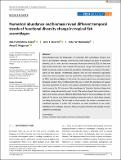Files in this item
Numerical abundance and biomass reveal different temporal trends of functional diversity change in tropical fish assemblages
Item metadata
| dc.contributor.author | Fontrodona-Eslava, Ada | |
| dc.contributor.author | Deacon, Amy Elizabeth | |
| dc.contributor.author | Ramnarine, Indar W. | |
| dc.contributor.author | Magurran, Anne | |
| dc.date.accessioned | 2021-06-28T13:30:03Z | |
| dc.date.available | 2021-06-28T13:30:03Z | |
| dc.date.issued | 2021-06-25 | |
| dc.identifier | 274462284 | |
| dc.identifier | e480c6a8-a103-4106-887b-153ed40ee85e | |
| dc.identifier | 000666395400001 | |
| dc.identifier | 85108838649 | |
| dc.identifier.citation | Fontrodona-Eslava , A , Deacon , A E , Ramnarine , I W & Magurran , A 2021 , ' Numerical abundance and biomass reveal different temporal trends of functional diversity change in tropical fish assemblages ' , Journal of Fish Biology , vol. Early View . https://doi.org/10.1111/jfb.14812 | en |
| dc.identifier.issn | 0022-1112 | |
| dc.identifier.other | ORCID: /0000-0002-0036-2795/work/96489450 | |
| dc.identifier.uri | https://hdl.handle.net/10023/23427 | |
| dc.description | Funding: Fisheries Society of the British Isles; European Research Council (Grant Number(s): ERC AdG BioTIME 250189); The Leverhulme Trust (Grant Number(s): RPG-2019-402). | en |
| dc.description.abstract | Understanding how the biodiversity of freshwater fish assemblages changes over time is an important challenge. Until recently most emphasis has been on taxonomic diversity but it is now clear that measures of functional diversity can shed new light on the mechanisms that underpin this temporal change. Fish biologists use different currencies, such as numerical abundance and biomass, to measure the abundance of fish species. However, because they are not necessarily equivalent, these alternative currencies have the potential to reveal different insights into trends of functional diversity in natural assemblages. Here we asked how conclusions about temporal trends in functional diversity are influenced by the way in which the abundance of species has been quantified. To do this we computed two informative metrics, for each currency, for 16 freshwater fish assemblages in Trinidad's Northern Range that had been surveyed repeatedly over five years. We found that numerical abundance and biomass uncover different directional trends in these assemblages for each facet of functional diversity, and as such inform hypotheses about the ways in which these systems are being restructured. On the basis of these results we concluded that a combined approach, in which both currencies are employed, contributes to our understanding of the ecological processes that are involved in biodiversity change in freshwater fish assemblages. | |
| dc.format.extent | 8 | |
| dc.format.extent | 1482592 | |
| dc.language.iso | eng | |
| dc.relation.ispartof | Journal of Fish Biology | en |
| dc.subject | Biomass | en |
| dc.subject | Freshwater fish | en |
| dc.subject | Functional diversity | en |
| dc.subject | Numerical abundance | en |
| dc.subject | QL Zoology | en |
| dc.subject | DAS | en |
| dc.subject | SDG 15 - Life on Land | en |
| dc.subject.lcc | QL | en |
| dc.title | Numerical abundance and biomass reveal different temporal trends of functional diversity change in tropical fish assemblages | en |
| dc.type | Journal article | en |
| dc.contributor.sponsor | The Leverhulme Trust | en |
| dc.contributor.sponsor | European Research Council | en |
| dc.contributor.sponsor | European Research Council | en |
| dc.contributor.institution | University of St Andrews. School of Biology | en |
| dc.contributor.institution | University of St Andrews. Centre for Biological Diversity | en |
| dc.identifier.doi | https://doi.org/10.1111/jfb.14812 | |
| dc.description.status | Peer reviewed | en |
| dc.identifier.url | https://onlinelibrary.wiley.com/doi/10.1111/jfb.14812#support-information-section | en |
| dc.identifier.grantnumber | ORPG-8061 | en |
| dc.identifier.grantnumber | 250189 | en |
| dc.identifier.grantnumber | 727440 | en |
This item appears in the following Collection(s)
Items in the St Andrews Research Repository are protected by copyright, with all rights reserved, unless otherwise indicated.

